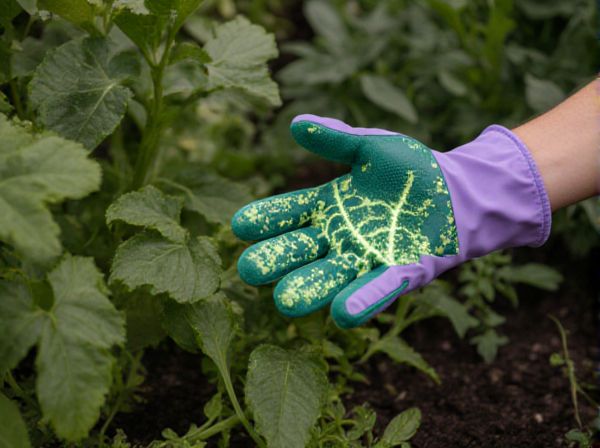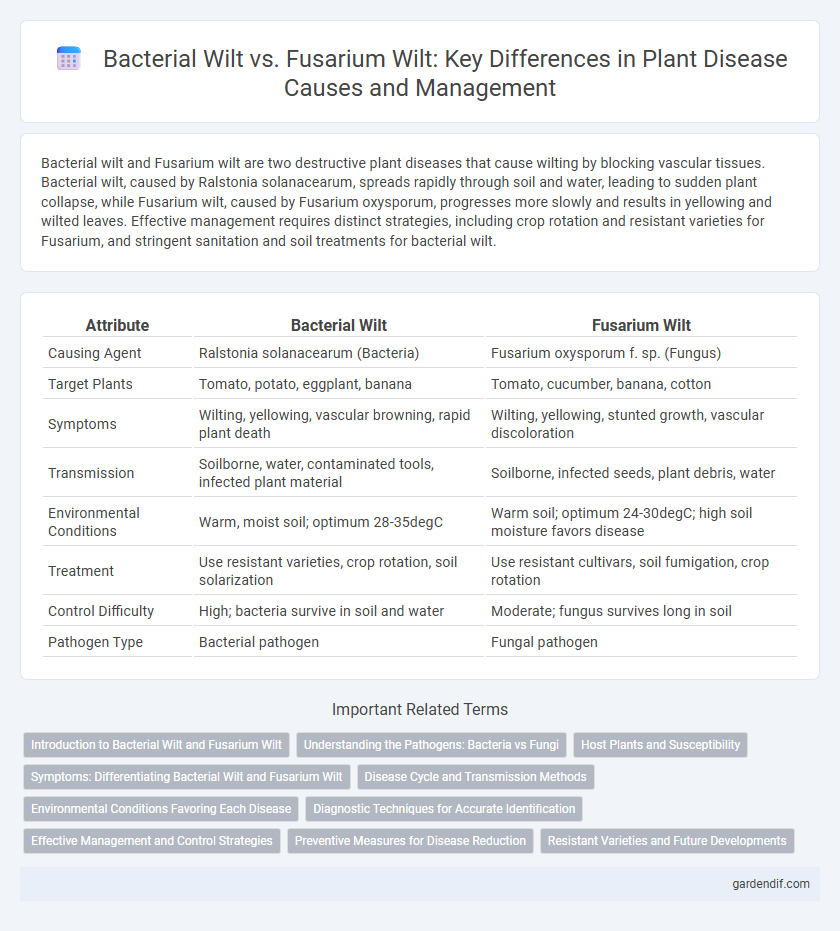
Bacterial wilt vs Fusarium wilt Illustration
Bacterial wilt and Fusarium wilt are two destructive plant diseases that cause wilting by blocking vascular tissues. Bacterial wilt, caused by Ralstonia solanacearum, spreads rapidly through soil and water, leading to sudden plant collapse, while Fusarium wilt, caused by Fusarium oxysporum, progresses more slowly and results in yellowing and wilted leaves. Effective management requires distinct strategies, including crop rotation and resistant varieties for Fusarium, and stringent sanitation and soil treatments for bacterial wilt.
Table of Comparison
| Attribute | Bacterial Wilt | Fusarium Wilt |
|---|---|---|
| Causing Agent | Ralstonia solanacearum (Bacteria) | Fusarium oxysporum f. sp. (Fungus) |
| Target Plants | Tomato, potato, eggplant, banana | Tomato, cucumber, banana, cotton |
| Symptoms | Wilting, yellowing, vascular browning, rapid plant death | Wilting, yellowing, stunted growth, vascular discoloration |
| Transmission | Soilborne, water, contaminated tools, infected plant material | Soilborne, infected seeds, plant debris, water |
| Environmental Conditions | Warm, moist soil; optimum 28-35degC | Warm soil; optimum 24-30degC; high soil moisture favors disease |
| Treatment | Use resistant varieties, crop rotation, soil solarization | Use resistant cultivars, soil fumigation, crop rotation |
| Control Difficulty | High; bacteria survive in soil and water | Moderate; fungus survives long in soil |
| Pathogen Type | Bacterial pathogen | Fungal pathogen |
Introduction to Bacterial Wilt and Fusarium Wilt
Bacterial wilt, caused by Ralstonia solanacearum, is a soil-borne pathogen that infects over 200 plant species, leading to rapid wilting and plant death through vascular system blockage. Fusarium wilt, induced by Fusarium oxysporum f. sp. strains, is a fungal disease that causes yellowing, wilting, and vascular discoloration primarily in crops like tomatoes and bananas. Both diseases critically impair water and nutrient transport, resulting in significant yield losses worldwide.
Understanding the Pathogens: Bacteria vs Fungi
Bacterial wilt is caused by soilborne bacteria such as Ralstonia solanacearum, which invade plant vascular tissues through roots and spread rapidly via xylem vessels, leading to systemic wilting. Fusarium wilt results from infection by Fusarium oxysporum, a soilborne fungal pathogen that produces chlamydospores and colonizes xylem vessels, gradually obstructing water transport. Understanding the distinct pathogen types--bacteria versus fungi--allows for tailored disease management strategies targeting their unique infection mechanisms and survival structures.
Host Plants and Susceptibility
Bacterial wilt, caused by Ralstonia solanacearum, primarily affects solanaceous crops such as tomatoes, potatoes, and eggplants, exhibiting high susceptibility in these hosts. Fusarium wilt, caused by Fusarium oxysporum f. sp. lycopersici, targets a broader range of plants including tomatoes, bananas, and cucurbits, with varying degrees of resistance observed among cultivars. Both diseases significantly impact crop yield due to their ability to invade the vascular system, but host susceptibility is often influenced by specific pathogen races and plant genetic resistance.
Symptoms: Differentiating Bacterial Wilt and Fusarium Wilt
Bacterial wilt causes rapid wilting and collapse of the plant, often accompanied by sticky bacterial ooze when the stem is cut, while Fusarium wilt typically leads to yellowing and browning of lower leaves progressing to the entire plant over time. Infected plants with bacterial wilt usually exhibit a sudden and complete wilting without leaf spot symptoms, whereas Fusarium wilt shows vascular discoloration in the stem and more gradual symptom development. The presence of a viscous, milky bacterial exudate distinguishes bacterial wilt from the dry, brown streaks characteristic of Fusarium wilt in the vascular tissues.
Disease Cycle and Transmission Methods
Bacterial wilt, caused by Ralstonia solanacearum, primarily spreads through soil, contaminated water, and infected plant material, entering host plants via root wounds or natural openings. Fusarium wilt, caused by Fusarium oxysporum f. sp. species-specific to host plants, infects through the soil and colonizes the vascular system, transmitted mainly by soil-borne spores and infected debris. Both diseases survive in soil or plant residues, enabling persistent infection cycles that complicate crop management and control.
Environmental Conditions Favoring Each Disease
Bacterial wilt thrives in warm, moist environments with temperatures between 25-35degC and high soil moisture, often spreading rapidly in poorly drained soils. Fusarium wilt prefers slightly cooler conditions, around 20-28degC, and drier soils with lower humidity, favoring sandy or well-drained soils for fungal proliferation. Both diseases are influenced by soil pH, with bacterial wilt tolerating a broader pH range while Fusarium wilt favors acidic to neutral soils around pH 5.5-7.0.
Diagnostic Techniques for Accurate Identification
Bacterial wilt and Fusarium wilt can be accurately identified using molecular diagnostic techniques such as polymerase chain reaction (PCR), which detects specific DNA sequences unique to Ralstonia solanacearum and Fusarium oxysporum, respectively. Culture isolation on selective media followed by microscopic examination helps differentiate bacterial colonies from fungal spores, while symptomatology alone often leads to misdiagnosis. Advances in immunoassays, including ELISA, provide rapid and reliable field-level detection, enhancing management strategies for both pathogens.
Effective Management and Control Strategies
Effective management of Bacterial wilt involves crop rotation with non-host plants, use of resistant varieties, and strict sanitation practices to prevent the spread of the Ralstonia solanacearum pathogen. Fusarium wilt control relies on planting Fusarium-resistant cultivars, soil solarization, and proper irrigation management to reduce Fusarium oxysporum f. sp. specific inoculum levels. Both diseases benefit from integrated pest management approaches combining biological control agents and optimized soil health to enhance plant resistance and minimize pathogen survival.
Preventive Measures for Disease Reduction
Effective preventive measures for bacterial wilt include crop rotation with non-host plants, the use of disease-free seeds, and proper sanitation of tools to minimize pathogen spread. For Fusarium wilt, planting resistant cultivars and maintaining well-drained soil with balanced pH levels significantly reduce infection rates. Both diseases benefit from avoiding over-irrigation and removing infected plant debris to limit pathogen survival in the soil.
Resistant Varieties and Future Developments
Resistant varieties for bacterial wilt primarily include tomato cultivars like Hawaii 7996, which show strong resistance due to specific R-genes. Fusarium wilt resistance is often achieved through cultivars with the I, I-2, and I-3 genes, providing effective defense against different races of Fusarium oxysporum f. sp. lycopersici. Future developments focus on gene editing technologies such as CRISPR to enhance resistance durability and combining multiple resistance genes to broaden protection against evolving pathogen strains.
Bacterial wilt vs Fusarium wilt Infographic

 gardendif.com
gardendif.com